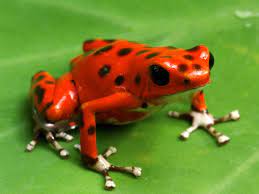The Strawberry Poison Dart Frog (Oophaga pumilio), also known as the Blue Jeans Frog or Strawberry Poison Arrow Frog, is a small and brightly colored species of poison dart frog native to Central America. These frogs are renowned for their vibrant and striking coloration, which serves as a warning to potential predators that they are toxic.
Here are some key features and facts about the Strawberry Poison Dart Frog:
- Size: Adults are relatively small, typically measuring between 1 to 2 inches (2.5 to 5 centimeters) in length.
- Coloration: As the name suggests, these frogs often have a bright red or orange coloration with blue or black markings. However, the exact coloration can vary among different populations, and some individuals may exhibit variations in color.
- Toxicity: The bright colors of these frogs are a form of aposematism, which is a warning signal to predators that they are toxic. The skin of the Strawberry Poison Dart Frog contains potent alkaloid toxins, which are believed to be derived from the ants and mites they consume in the wild. In captivity, where they have a different diet, these frogs may not be as toxic.
- Habitat: They are typically found in humid tropical rainforests, often near water sources. They are known to inhabit areas with high humidity, such as leaf litter on the forest floor.
- Behavior: Strawberry Poison Dart Frogs are diurnal (active during the day) and are known for their distinctive hopping gait. They are also known to be territorial and exhibit parental care. Females lay their eggs in leaf litter, and once the eggs hatch, the male transports the tadpoles to water sources like small pools or bromeliads, where they continue their development.
- Conservation: While the Strawberry Poison Dart Frog is not currently listed as endangered, some populations may be at risk due to habitat loss and collection for the pet trade. Conservation efforts are in place to protect their natural habitats.
It’s important to note that captive-bred individuals available in the pet trade may not be as toxic as their wild counterparts, as their toxicity is often linked to their natural diet in the wild. If considering keeping them as pets, it’s crucial to research and understand their specific care requirements, including proper diet and habitat conditions. Additionally, responsible sourcing from reputable breeders is essential to ensure the well-being of these fascinating amphibians.
